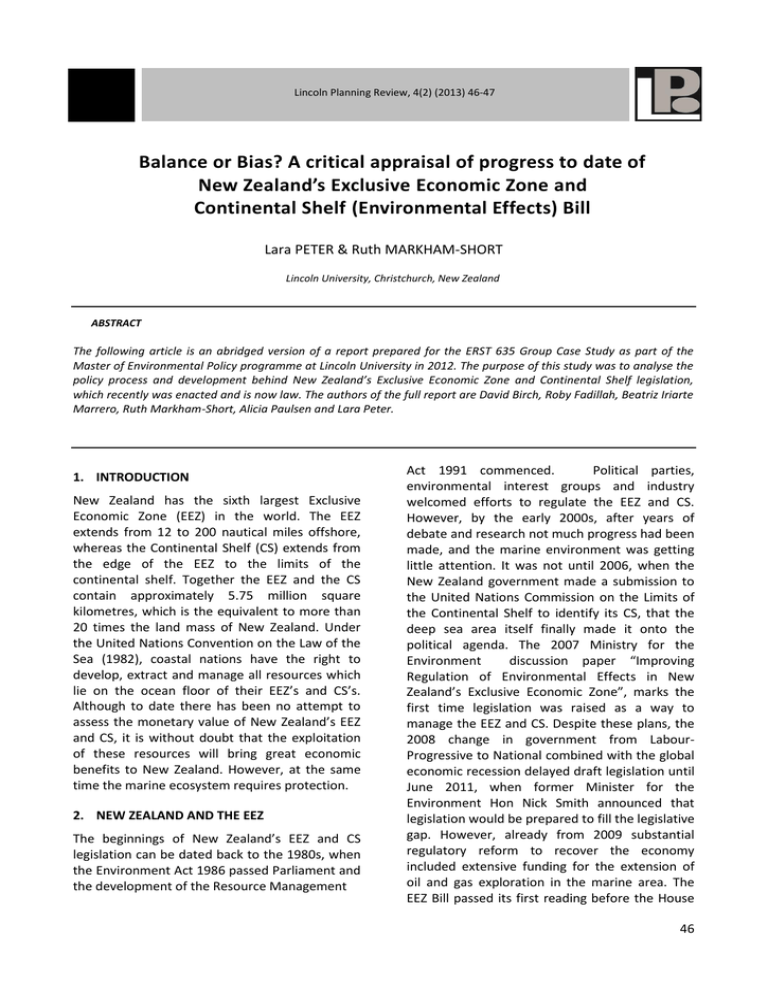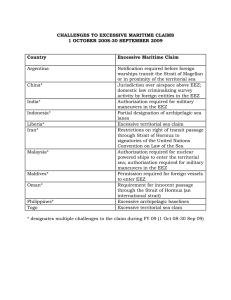Balance or Bias? A critical appraisal of progress to date... New Zealand’s Exclusive Economic Zone and
advertisement

Lincoln Planning Review, 4(2) (2013) 46-47 Balance or Bias? A critical appraisal of progress to date of New Zealand’s Exclusive Economic Zone and Continental Shelf (Environmental Effects) Bill Lara PETER & Ruth MARKHAM-SHORT Lincoln University, Christchurch, New Zealand ABSTRACT The following article is an abridged version of a report prepared for the ERST 635 Group Case Study as part of the Master of Environmental Policy programme at Lincoln University in 2012. The purpose of this study was to analyse the policy process and development behind New Zealand’s Exclusive Economic Zone and Continental Shelf legislation, which recently was enacted and is now law. The authors of the full report are David Birch, Roby Fadillah, Beatriz Iriarte Marrero, Ruth Markham-Short, Alicia Paulsen and Lara Peter. 1. INTRODUCTION New Zealand has the sixth largest Exclusive Economic Zone (EEZ) in the world. The EEZ extends from 12 to 200 nautical miles offshore, whereas the Continental Shelf (CS) extends from the edge of the EEZ to the limits of the continental shelf. Together the EEZ and the CS contain approximately 5.75 million square kilometres, which is the equivalent to more than 20 times the land mass of New Zealand. Under the United Nations Convention on the Law of the Sea (1982), coastal nations have the right to develop, extract and manage all resources which lie on the ocean floor of their EEZ’s and CS’s. Although to date there has been no attempt to assess the monetary value of New Zealand’s EEZ and CS, it is without doubt that the exploitation of these resources will bring great economic benefits to New Zealand. However, at the same time the marine ecosystem requires protection. 2. NEW ZEALAND AND THE EEZ The beginnings of New Zealand’s EEZ and CS legislation can be dated back to the 1980s, when the Environment Act 1986 passed Parliament and the development of the Resource Management Act 1991 commenced. Political parties, environmental interest groups and industry welcomed efforts to regulate the EEZ and CS. However, by the early 2000s, after years of debate and research not much progress had been made, and the marine environment was getting little attention. It was not until 2006, when the New Zealand government made a submission to the United Nations Commission on the Limits of the Continental Shelf to identify its CS, that the deep sea area itself finally made it onto the political agenda. The 2007 Ministry for the Environment discussion paper “Improving Regulation of Environmental Effects in New Zealand’s Exclusive Economic Zone”, marks the first time legislation was raised as a way to manage the EEZ and CS. Despite these plans, the 2008 change in government from LabourProgressive to National combined with the global economic recession delayed draft legislation until June 2011, when former Minister for the Environment Hon Nick Smith announced that legislation would be prepared to fill the legislative gap. However, already from 2009 substantial regulatory reform to recover the economy included extensive funding for the extension of oil and gas exploration in the marine area. The EEZ Bill passed its first reading before the House 46 on 13th September 2011 and was enacted on 3rd September 2012. During its development process the EEZ Act received criticism from the political opposition and environmental stakeholders. The main points of criticism were related to the comparatively weak adaption of the precautionary approach, the fact that there is no right to appeal to the Environment Court under the EEZ Act, and the lack of reference to sustainable development or sustainable management, which is central to the RMA 1991. In particular, the Labour Party criticised the draft legislation for being a “developer’s agenda” (Charles Chauvel, list Member of Parliament for the New Zealand Labour Party, Hansard Debates, 13th September 2011). Furthermore, the Environmental Defence Society and other stakeholders raised concerns about the capacity of the Environmental Protection Authority to be the consenting authority and decide on applications for activities under the EEZ Act. However, the central point of reference for criticism was the purpose of the draft legislation, namely the “balance between the protection of the environment and economic development”. The inherent problem with this purpose is that it aimed to balance two elements (the environment and the economy) that can never be balanced. It is only possible to balance things that are separate from each other. At this stage the EEZ Bill was a rather technical piece of legislation with a diffuse problem definition, a vague purpose and a narrow concept of the environment which did not adequately reflect the nested nature of the environment, society and the economy. As a result of the strong criticism, the final Act has been aligned with the RMA and now states as its purpose the sustainable management of the natural resources of the EEZ and CS. Furthermore, the formerly rather weak penalties for non-compliances were raised from a maximum of $600,000 to $10 million, and the transition period for permits was increased from 6 to 12 months. Regulations are currently being developed for the technical details of the Act. However, some of the opposition’s objections, such as the lack of public participation, the missing access to the Environment Court and a lack of guidelines for environmental impact assessments under the Act, have not been reflected in the final legislation. Although economic growth seems to have been the driving factor behind the policy process, particularly during the time before the first reading of the Bill, the final EEZ Act does to some extent provide for environmental protection. The concerns about the legislation, both at the time before the first reading and the still remaining concerns, can be linked back to the policy development process. Factors such as political power and hierarchy, institutions, normative and positivist aspects (science, values and different kinds of knowledge), the struggle for balancing different worldviews, as well as environmental and economic matters, and methods of decision making have shaped this process. The biggest methodological challenge for analysing this process was to make valid assumptions about the connections between these factors, and to find evidence for the causation of these factors for the policy outcome. As students of ERST 635 we undertook a field trip to Wellington to interview representatives of the Environmental Protection Authority (EPA), the Green Party and the Environment and Conservation Organisation of Aotearoa (ECO) and also received comments from Hon Amy Adams. However, our interviews were certainly not representative, and whilst they provided some valuable information, our methodological soundness would have benefitted from more time to conduct further interviews. Our conclusion is that some significant weaknesses in the policy process (such as the lack of public participation) tended to be reflected in the policy itself, which may or may not be inherent to New Zealand’s system of political decision making. 3. CONCLUSION For planners at the local and regional level, the EEZ Act is a further indication of a slow deferral of political power from the regional level to central government and its authorities, such as the EPA. Whilst this can be justified for an (inter)national issue such as marine resources, the EEZ Act fails to reflect that it is indeed the regional councils who have authority over some of these resources (within 12 nautical miles) - this may be another signal of the current tendency to centralise environmental decision making in New Zealand. 47



